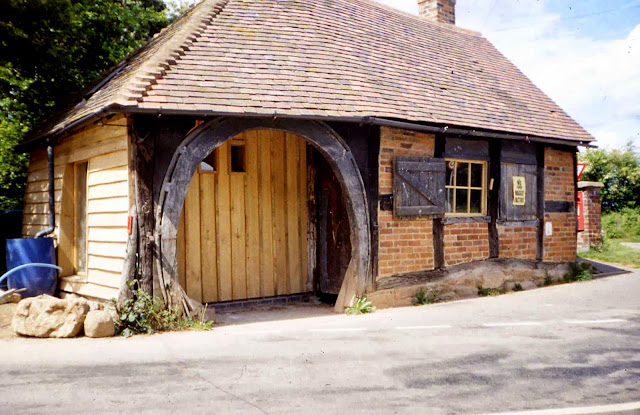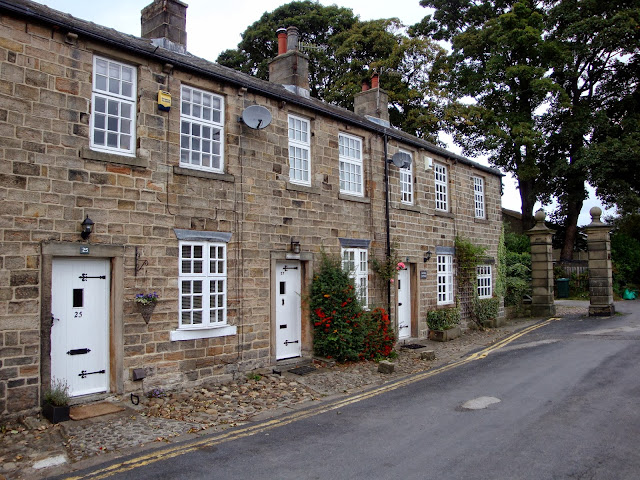This page is about curious buildings which have, or have had, a practical use
The Old Forge
The Old Forge at Claverdon in Warwickshire is a small half
timbered building much like any other forge which was once to be found in most
villages.
The unusual feature of this
one is the entrance which is in the shape of a huge horseshoe.
Upsall 'Town'
The tiny estate village of Upsall is situated on the western
slope of the Hambledon Hills near to Thirsk in North Yorkshire. Don’t blink as you pass through this place
or you may miss it! – yet it contains two unusual buildings, as well as a
castle.
The Old Forge is a fine Victorian
building which has an unusual horseshoe shaped entrance, above which is the
curious inscription – Upsall 1859
Town. Although it appears that Upsall was never more
than just a tiny village, it does have a Town Hall! This rather impressive building just across
the road from the forge, also has an inscription over the entrance – 1928 – Town Hall. Actually, Upsall has had no less than
three castles on the same site over the years.
The Scrope family built their castle there in the 14th
century but it later became a ruin. A
splendid Gothic castle, built in the late 19th century, was burned
down in 1918, being replaced in 1924 and it is still occupied as a family
house. Maybe the Lord of the Manor
wanted to live in a town.
Upsall Forge
Upsall Town Hall
The Granary
Bee Boles
Bee Boles
Another interesting old farm
building can be seen alongside the A165 Malton to Pickering road close to the
A64 in North Yorkshire. The building has
several ‘niches’ built into the back wall – they are to accommodate ‘bee boles’
which were straw bee hives, the predecessor’s of the modern wooden hive. Honey was a very important product for
sweetening purposes prior to the introduction of sugar, and beekeeping was
therefore a very important branch of husbandry.
A Georgian Ice-house
A curious double skinned brick
building to be seen in the grounds of Sutton Park at Sutton-on-the-Forest near
York, is a fine example of a Georgian ice-house. This egg shaped structure is built half underground and was an essential
part of the large houses in Georgian and Victorian times for the storage of
huge quantities of ice at a time when refrigeration was unknown, the ice being
used to preserve food and to keep drinks cool.
The ice house
The Leech House
This unique little castellated building is to be seen at the side of Bedale Beck at Bedale in North Yorkshire. . It is a 'leech house' the only one of it's kind and listed as a Grade 11 building.
It was used by the local apothecary for the storing of leeches, around the time that they were
used in medical practice.
The Leech House
This unique little castellated building is to be seen at the side of Bedale Beck at Bedale in North Yorkshire. . It is a 'leech house' the only one of it's kind and listed as a Grade 11 building.
It was used by the local apothecary for the storing of leeches, around the time that they were
used in medical practice.
 |
The Leech House |
Robin Hood's Well
The area surrounding Barnsdale near Doncaster in South Yorkshire was once a part of a densely wooded area and a favourite haunt of the notorious outlaw Robin Hood. At Burgwallis on the modern A1 road there is a well, covered by a very fine stone shelter. The story goes that Robin captured the Bishop of Hereford at this spot and made him dance around a tree until he was exhausted and then relieved him of the £300 he was carrying. The well marks the spot and has been known as Robin Hood’s Well since the time of Henry V111 at least. The present edifice was erected by the Earl of Carlisle and attributed to Vanburgh. It was moved from the north side of Skell Brook to its present position when the road was widened. The Robin Hood Inn, which once stood nearby, displayed a three pint leather bottle, said to have belonged to Robin Hood.
The Watch House
The stealing of bodies from graveyards was a prevalent crime in the 19th century, and it was very difficult to apprehend these ‘body snatchers’ unless they were caught red-handed. To this end, watch towers were built in many graveyards where those keeping watch could shelter and still be vigilant. An interesting example of such a watch tower can be seen in the churchyard at Eckford, in the Scottish Borders. It even contains a small fire place to keep the incumbents nice and cosy.
A
story tells of a local man, one James Goodfellow, who was walking home late,
the day after a burial, when he saw a dim light in the churchyard. He saw a
pony and cart secreted nearby and sent it galloping off, forcing two miscreants
to leave their grisly task and rush after it. In the graveyard he found an open
coffin and just had time to hide the body behind a nearby gravestone and
install himself in the coffin, covering himself with the pall, before the two body snatchers returned and lifted the coffin
on to the cart and drove towards Kelso. After a short distance one of them
leaned against the ‘body’ and cried “Jock, this body’s warm” whereupon James sat
up and said, “If you had been where I have been, you would be warm” and the
thieves fled. There was apparently no claim for the impounded horse and cart.
Iron Row
A row of terrace houses in Burley
in Wharfedale in Yorkshire is known as Iron Row. The houses were built c1800 by
the local mill owners, Greenwood and Whitaker, to house their employees.
Originally called New Row, the one up one down cottages were described as ‘fire
proof’ in that no wood was used. They were an all stone construction and the
roofs were supported by stone barrel vaults. Iron doors also protected the
properties against the possibility of Luddite attack.
The row remained
unchanged until the estate was sold in 1968 and are now much sought after
modernised dwellings.
Wager
Cottage
The
former Wager Cottage, now called Column Cottage, is a Grade 11 listed building
in Bondgate Without at Alnwick in Northumberland. It is said that it was built
in two weeks around 1817 for the Duchess of Northumberland. This was apparently to win a wager between the
Duchess and the 3nd Duke. The Percy Crescent is over the door.
Whisky vat
houses
There
are a variety of ecological houses at the Findhorn Foundation Ecovillage on the
Moray coast in north Eastern Scotland. Tucked away in a corner are several
houses which have been constructed from redundant whisky vats.
 |
Whisky vat houses |
















No comments:
Post a Comment